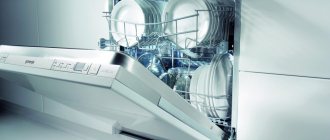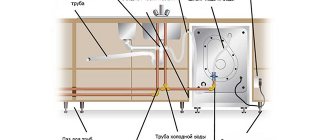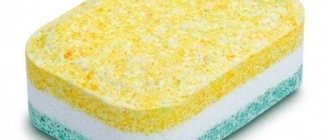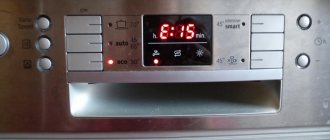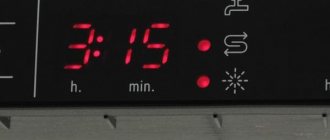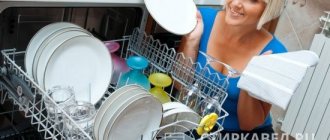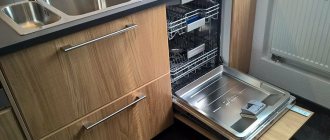Each of us is familiar with the feeling of impatience when we want to quickly try out a new household appliance that we just purchased in the store. But there are times when there is no need to rush, for example, the first start-up of a Bosch, Samsung or any other brand dishwasher should be carried out according to the instructions.
The equipment of different manufacturers differs significantly, so strict adherence to the instructions contained in the manual is mandatory during the first use . You will find general information and useful tips in our article.
Do not rush to put dishes in a new dishwasher - you do not need to do this during the first start
Procedure
In order for the device to serve without complaints for many years, you need to figure out how to start the dishwasher for the first time. Test switching on the machine helps to clear the chamber of debris and make sure the heater is working properly.
You should adhere to the following algorithm:
- It is necessary to check the connections and set the temperature settings correctly.
- Before starting work, you should clean the camera from packaging material. You need to remove the factory stickers and check the condition of the filter. The device has a salt compartment into which you need to pour water and add salt crystals.
- A special compartment for detergent is filled with gel or a tablet is used. The dispenser can be seen on the back of the door. It is important to find the appropriate type of cleaner on the control panel and specify it correctly.
- You need to choose a program; it is better to choose a long-term mode with high temperature.
- The device is turned on after pressing the “Start” button.
The best place for a dishwasher
The best place to place a dishwasher (hereinafter also referred to as dishwashers, PMM) is in the kitchen. You need to decide where the equipment will be placed before purchasing it. Much depends on whether furniture is installed in the kitchen and whether there is a free opening in it to build in a dishwasher.
Manufacturers produce two types of dishwashers: built into kitchen furniture and free-standing. Built-in PMMs come in three types (hereinafter W – width, H – height, D – depth):
- full-size – W 54-60 cm, H 80-86 cm, D 54-63 cm;
- narrow – W 44-45 cm, H 80-86 cm, D 54-63 cm;
- compact – W 40 cm, H 44 cm, D 50 cm.
Fully built-in narrow Bosch dishwasher
Built-in PMMs are divided into two categories: fully and partially built-in. For the former, the control panel is located at the end of the door and is completely covered by the facade of the furniture. The doors of partially built-in dishwashers can be partially closed with decor, since the control panel and handle are located outside.
Partially built-in full-size dishwasher
If installing a built-in Bosch dishwasher is not possible for some reason, choose a model that can be placed separately. A family of two living in a small apartment will need a compact dishwasher, which can be installed in a separate cabinet or under the sink (see photo below).
Compact Bosch dishwasher in the cabinet under the sink
If you have not yet purchased kitchen furniture and want to place full-size household appliances there, first measure or take its dimensions from the documentation. This way you can order cabinets with openings of the required sizes.
An example of calculating a furniture opening for the dimensions of the selected PMM model
The best location for the dishwasher in the kitchen is no further than 1.5 m from the sink, near which it is most convenient to connect to the water supply and sewerage system. Experts note that otherwise, malfunctions of this equipment or premature wear of the drain pump are possible.
The dishwasher and washing machine are built into the furniture next to the sink
When installing PMMs near water supply and sewer outlets is impossible, it will be necessary to organize the supply and drainage of water through new connections to nearby sections of pipelines. There are no particular difficulties with small water pipes. Drainage will be more difficult to work with. In addition, you will have to buy long hoses, since you rarely find parts longer than 1.5 m included with the products.
Where to start using
After you have made a purchase and received it via the delivery service, you can proceed to the actual operation of the device.
- Initially, you need to start installing the dishwasher in a permanent place. The floor surface must be level, otherwise you need to level it using a level.
- Hoses for water supply and drainage are connected.
- After connecting the hoses and checking the seal, you can open the water supply valve.
- Now it’s time to read the manufacturer’s instructions so as not to violate the recommended rules for using the equipment.
- Check the contents inside the machine; there should be no forgotten parts, polystyrene foam or manufacturer’s stickers.
- Place detergent in the dishwasher.
- Connect the device to the network, it must be checked for functionality in test mode and only then proceed to a full operational launch of the dishwasher.
“Idle” mode is a necessary procedure that will reveal improper functioning or its complete absence. Which may be caused by mechanical or human factors, so be sure to run a test run before starting operation.
Testing the device in “idle” mode is due to the following points:
- The need to check the functionality of equipment is aimed at identifying possible defects in assembly, transportation or improper installation of equipment and components.
- Cleaning function. Running the dishwasher in “idle” mode allows you to get rid of various contaminants and lubricant residues.
- Initial familiarization with the functions of starting up and operating the equipment. Before loading the dishes directly, you will be able to understand the operating features of the household appliance.
Suitable detergents for dishwashers
Dishwasher users must purchase a starter kit, which is usually offered with their main purchase.
You can separately purchase rinse aid, detergents in tablets or special powder, as well as salt for softening tap water , which we have already discussed.
The starter kit includes all the detergents, without which it is simply impossible to operate any dishwasher - this is a mandatory minimum
The advantage of starter kits for beginners is that they already include everything you might need.
In addition, they include products from the same manufacturer, which allows us to hope that their components are not only perfectly compatible, but also successfully complement each other.
Often, purchasing a set will cost less than purchasing its components, sold separately from each other.
In addition to the three absolutely necessary components, fragrances and products can be used for effective washing to help clean the car itself from grease and plaque. As a rule, they are purchased as the need for them arises.
Water softening salt
For high-quality dishwashing, soft water with a low content of calcium salts should be used. If hard water is not softened, scale marks will form on the walls of the chamber over time.
Salt allows you to bring water to a state in which the results of the equipment’s operation please its owner.
Regenerating salt for loading into the dishwasher should not be confused with ordinary table salt, which everyone has in their kitchen: this is a special substance for softening tap water
What means can be used?
Bosch machines can use any detergent that is on sale today. It can be:
- compressed tablets;
- powder;
- liquids.
The only restriction that must be strictly observed: these must be special substances intended for loading into dishwashers. Do not use chemicals to wash dishes manually.
The detergents used must be intended for processing dishes specifically in dishwashers, and those used for manual washing cannot be used
Depending on the composition of their components, there are three types of dishwasher detergents:
- with chlorine and phosphates;
- without chlorine, but with phosphates;
- without phosphates and without chlorine.
If there are no phosphates in the product, a white coating may form on the walls of the chamber and on the dishes themselves . To avoid such consequences, you have to increase the consumption of detergent.
The absence of chlorine will not provide the desired effect if the dishes need to be bleached. Dark deposits on cups and grayed plastic may be the result of a lack of chlorine.
The situation can be saved by washing with increased intensity or increasing the consumption of detergent.
Why do you need a rinse aid?
When using rinse aid, which enters the chamber at the last stage of washing, water drops do not leave marks on the dishes.
If you do not use this preparation while the machine is operating, then after drying, unaesthetic stains will remain on the glassware. In addition, it is a high-quality rinse aid that ensures the shine of clean dishes.
Rinse aids give the glass that same gloss and shine that any housewife strives for, but it is important to use them in moderation so that the dishes do not become sticky and are not covered with whitish or rainbow stains
The volume of rinse aid can be changed depending on need. If this liquid was not enough, you will see a white coating on the plates and they will be dull. In this case, the dose is increased.
Excess of the drug will appear as rainbow stains on the pans. They will also feel sticky to the touch. Then the dose is reduced.
Special detergents
There are combination drugs that are called “three in one”. They contain all three components listed above.
The disadvantage of such products is the inability to adjust the salt content, as recommended by Bosch equipment manufacturers.
Water that is too hard impairs the quality of washing, and water that is too soft contributes to glass corrosion: calcium is washed out of its composition.
If you have to wash silver products, you must use detergents specially designed for this purpose . Others won't work.
You can see the order in which detergents are loaded and which compartments of the cuvette located on the inner surface of the door are filled with in the videos that we invite you to watch. They are in the last part of the article.
Rules of care and use
To extend the life of the model, it is necessary to ensure proper care of the device. After completing the washing session, you must keep the hopper door open. The moisture will quickly evaporate from the unit. These actions are the prevention of mold.
The cutlery basket should not be cleaned with harsh chemicals.
The rubber gasket located on the door should be wiped regularly with a dry sponge. After each use of the device, the outer surface should be wiped with a damp cloth.
Preparing to download
Before placing plates on the shelves and compartments of the PMM, clear them of food debris. The better you do this, the higher the likelihood of avoiding filter and drain blockages.
On a note! To remove food debris from plates, use paper towels or napkins, a damp sponge, or a rubber spatula, whichever is more convenient. Make sure that there are no eggshells, fruit seeds, or grains left - these are enemies of the drainage system and provocateurs of blockages.
Don't know whether to rinse plates before loading them into the PMM? After rinsing, the quality of washing improves. But equipment owners justifiably wonder why they need a machine if they need to wash it by hand. Therefore, there are models with the “Soak” or “Pre-wash” function. If this option is not available, you will have to soak the plates.
First wash
There is no need to rush to launch the PMM immediately after the test run. It will take time to cool down. How long and well it will last will depend on the correct use of the equipment.
Before you put the dishes into compartments, you need to inspect them. Remains of food are washed off under running water. If the machine has cooled down, load the dishes. Salt and rinse aid remain in the compartments after the first start, but you need to add detergent.
Proper loading is the key to clean dishes. There should be a distance between objects, then nothing will prevent the streams of water from rinsing the dishes.
Selection of household chemicals
PMM uses products in the form of powders, gels and tablets. Also, for the first start you need a special salt that softens the water. It prevents the formation of scale on machine elements.
When the product runs out, a special indicator lights up and housewives must add salt.
The amount of salt that is poured into the compartment depends on the degree of water hardness. City services have the data, but there are modern models of dishwashers on sale that determine it themselves.
Loading the cart correctly
If the owner of the PMM does not have the opportunity to read the instructions compiled by the dishwasher manufacturer, then the following recommendations should be followed:
- Frying pans, tureens, pots and any other large items are placed in the lower basket. If necessary, the stand located at the bottom can be removed,
- Glasses, dessert plates, forks, spoons and many other small items are placed on the upper shelves. It is important to maintain the distance between rows.
- Any dishes are placed upside down.
- There is no need to load easily breakable dishes and highly durable items into the machine at the same time. In case of urgent need for joint washing, you need to choose the temperature mode and program, taking into account the presence of fragile objects in the car.
Many dishwasher models have special compartments for small items. They are used to wash spoons and forks.
How to turn it on
The PMM is turned on as follows:
- loading cart;
- program selection;
- pressing the "Start" button.
You can start the dishwasher in 2-3 minutes. If after starting the program you need to put an object, the work is stopped by clicking “Stop process”. Such a button is available on PMMs produced by Bosch and other companies.
Unsuitable cookware
Dishwashers are suitable for most cutlery.
However, any rule has exceptions, so remember that you cannot put in the car:
- Wooden dishes can only be washed by hand, as wood swells and deteriorates from prolonged contact with water. This is also true for metal utensils with wooden handles.
- It is not recommended to place tin, copper, or silver items in the sink, otherwise they will tarnish.
- It is prohibited to place aluminum objects in the machine. A coating forms on them from contact with water.
- For containers with a vacuum lid, high temperatures may cause the seal to deteriorate.
- Decorative utensils may have paint peeling off.
- It is strictly forbidden to try to wash items contaminated with ash, wax or paint in the car. These substances can stain other dishes and the machine itself, and in the worst case, cause damage.
- Rusty cutlery will not only be damaged in the dishwasher, but will also lead to corrosion on still intact metal objects.
Does your kitchen have a dishwasher?
Of course! No, but it will be!
Operating instructions for Bosch dishwashers
On the facade of the dishwasher there is a control unit with a power button, keys for selecting modes, additional settings and an electronic display. Modern machines have up to ten different programs. Also, some machines are equipped with LEDs to inform you about the end of the mode, lack of detergents, high water hardness, possible leakage or water shutdown. Each program has its own intuitive icon and numerical value.
The first launch is the most important!
The first start after purchasing a dishwasher is a strategically important moment! Never neglect this step, otherwise you can significantly reduce the life of the machine. The first use should be idle, that is, without dishes and detergents at maximum temperature. This is necessary in order to check the correct installation, the presence of leaks, extraneous sounds during operation, and also to wash off factory lubricants and dust.
What problems can you fix yourself?
If your Bosch dishwasher fails, you need to contact your nearest service center for help. But sometimes the breakdown is so minor that it makes no sense to hire specialists to fix it.
The unit independently monitors the health of its own systems and, in the event of a problem, displays an error code on the display . The meaning of the codes can be found in the instructions for your machine.
A system that constantly tests its own operation, if a malfunction is detected, displays the following error codes:
Let's talk about those that you can eliminate on your own:
- E4 – there is a problem with switching the flow. This error can occur when the hose is clogged. If the hoses have been checked and the display still shows E4, contact service.
- E6 – there is a problem with the aquasensor, which is responsible for recognizing the level of contamination of the dishes. This error is typical for the Bosch Silence Plus . It appears if the intensive washing program is selected for dishes with minor stains.
- E15 - aquastop is turned on, that is, a reaction to a water leak has occurred. It is necessary to check all hoses and fix the problem.
- E17 - an error occurred in filling the liquid. This situation may arise if increased pressure has formed at the point where the water supply is connected to the dishwasher.
- E24 is a signal that waste water is poorly drained or not drained at all. The cause may be a clogged drain that will have to be cleaned, or a clogged hose. Perhaps the hose is simply pinched.
- E27 – power supply has deteriorated due to a drop in voltage in the electrical network. The cause of this phenomenon may be a peak load on the network. If you install a voltage stabilizer, this type of trouble can be avoided.
It happens quite often that the machine does not turn on. Most likely there is a problem with your network connection. Check the fuse, if it is blown, replace it.
It is possible that the dishwasher is blocked. Make sure to close the washer door properly. Check the sprinkler nozzles, water supply hoses and drain filters for clogging.
Introduction to the basic programs of Bosch dishwashers
- Choose a washing program based on the number of dishes and the degree of soiling.
- The automatic mode, using sensors inside the machine, automatically selects the duration and intensity of washing.
If there is a high degree of contamination or for burnt food, the “intensive” mode is suitable. The dishes will undergo soaking and several washing cycles at a temperature of eighty degrees, followed by drying. The Bosch 40E10RU series 2 is equipped with this program. Energy and water consumption will be less if you first remove the main contaminants under running hot water.
- If the pollution is not severe, select the “normal” mode. This one cycle of washing, rinsing and drying will be at a temperature of sixty degrees.
- The fast “economy” mode is intended for dishes without obvious contamination. For example, if you just need to refresh it before lunch. This mode is available in Bosch SMV30D20RU. Also, in some modifications there is a special Turbo washing mode for 20 minutes.
- The Bosch SPV4030RU machine has a “delicate” or Shine & Dry mode for fragile dishes.
- The Vario Speed Plus accelerated mode activates both water supply devices at once, thereby reducing washing time without loss of quality.
- A timer with a delayed start of up to a day will help you wash dishes, for example, only at night. This is convenient for those housewives in whose houses the payment for electricity changes at different times of the day.
How to care for PMM?
Rules of care
- Equipment should not be idle. Regular use of the device prevents the formation of bacteria - no matter how you wash the camera, microscopic food remains remain in it.
- During preventive measures, the chamber must be empty.
- Check the rotating nozzles for blockages and clean them if necessary. Clogged nozzles interfere with the normal flow of water - the dishes will not be washed properly.
- All parts of the PMM must be cleared of debris. To do this, use tweezers, toothpicks - in other words, something thin and pointed. If you use a metal tool, try not to leave scratches on the surface of the device.
- Wipe down doors and gaskets. There are places in the chamber that are washed worse than others during operation. They need to be thoroughly wiped with a cloth and special detergent. You can reach hard-to-reach areas with a toothbrush.
- Clean the bottom of the door—debris can accumulate in this so-called “dead spot.” Particularly thorough cleaning will be required here.
- Clean the bottom of the machine near the drain. To do this you will have to get baskets, because you need free access. Use caution - clean carefully. There may be fragments of broken dishes and other solids in the drain.
- Remove scale using one of the recommended products - special or homemade, such as vinegar and lemon juice. This procedure is performed last. The PMM is launched without dishes.
- Wash the front area with a sponge and a mild detergent. Pay special attention to the panel, handle and tabs.
- Refill your machine with fabric softener monthly. However, it is not necessary if you are using a water softener. In addition, rinse aid is contained in a number of detergents - read their composition.
- Clean the plastic elements with a brush. Use liquid soap if necessary.
Internal cleaning of PMM
To clean the inside of the machine, double caution is required:
- Disconnect the device from the power supply.
- After unscrewing the screws, remove the sprinkler and other elements. Try to remember the sequence of actions - you can even take a photo so you don’t miss anything during assembly. Store the parts in a safe place in the order in which they are removed.
- When finished cleaning, install the parts in reverse order. When tightening screws into plastic, do not use excessive force.
- Now you can connect the machine to the mains.
How to get rid of mold?
Fungus and mold cannot appear with the care described above. Their occurrence indicates a violation of the service rules. You should immediately begin to exterminate microorganisms and take measures to prevent their proliferation. Recommended action plan:
- Clean the inside of the appliance with bleach in a ratio of 0.5 cups per 1 liter of water;
- Wipe the chamber with a solution of ammonia in a ratio of 1/4 cup per liter of water;
- Turn on rinse mode.
To prevent the formation of mold, it is recommended not to close the machine door after the next wash.
Important! Bleach should be used with extreme caution - it is quite caustic. If the body is made of stainless steel, their use is prohibited. Bleach should not be used in combination with other chemicals.
How to get rid of rust?
Rust is already a direct threat to the performance of the elements affected by it. If corrosion stains appear on the basket, it is better to change it. You can also use sealant paint. In any case, it is important to understand what causes corrosion. It can be caused by high iron content in water. This may be due to a natural feature - and there is nothing you can do about it - or to rusty pipes. In any case, it is recommended to install special filters.
What should you pay attention to when choosing technology?
When choosing the optimal machine model, it is important to take the time to study the capabilities and characteristics of the offered equipment. In addition to class, size and installation method, several other aspects matter. The material from which the tank, rocker arms and baskets are made affects the durability of the units
It is important that as few parts and assemblies are made of plastic
The material from which the tank, rocker arms and baskets are made affects the durability of the units
It is important that as few parts and assemblies are made of plastic
The capabilities of the technology and its contents are also important to the user. Various modes allow you to better cope with the task. For example, the “soaking” mode helps to more effectively wash off dried dirt.
Dishwasher washing modes are described in the instructions
An installed system for determining the degree of water purity is necessary for the control unit to make a decision about draining the water or reusing it. Built-in drying is also very useful for owners. In everyday life, it is convenient to wash dishes with a half load.
Dishwasher Whirlpool ADPF 851 WH
Models are available with mechanical or electronic control. Most modern equipment is equipped with the second option, although it is considered less reliable.
BEKO DSFN 6530 dishwasher control panel
The noise level produced by a running unit is often of great importance. Especially for families with small children. It can vary in the range of 38...55 dB. To prevent the machine from causing inconvenience, it is better if the indicator does not exceed 45 dB.
The reliability of equipment is largely determined by the country of manufacture and manufacturers. Products manufactured by Miele, Electrolux, Bosch or AEG have long been proven for their quality.
Video - Electrolux ESF45055XR dishwasher
Of course, these brands cost a lot. Italian technology also performs well.
Italian kitchen appliances Smeg
Many people are suspicious of the products of Chinese factories, but recently decent models can be found in this segment.
Xiaomi smart dishwasher
General recommendations:
- do not place very dirty items in the corners - the center cleans better;
- do not wash greasy pans with delicate and fragile items - a residue will remain on the glass;
- if there are a lot of dirty large utensils (pans, pots, molds) - do not overload the machine, wash them separately.
The article describes how to load a standard depth dishwasher. But these tips also apply to desktop PMMs - you just need to adapt to the compact size of the devices.
Sources
- https://RemontCMA.ru/posudomoechnye-mashiny/ekspluatatsiya-pmm/sekrety-pravilnoj-zagruzki-posudy-v-posudomojku/
- https://nemoyrukami.ru/posudomoechnye-mashiny/kak-polzovatsya-pmm/kak-zagruzit-posudomoechnuyu-mashinu
- https://tehrevizor.ru/pravila-ekspluatacii/124-krupnaja-bytovaja-tehnika/kak-pravilno-zagruzhat-posudu-v-posudomoechnuju-mashinu.html
- https://tehno-gid.net/inf/kak-pravilno-zagruzit-posudomoechnuyu-mashinu-rasstavim-vsyo-na-svoi-mesta.html
- https://sovet-ingenera.com/tech/posudomoyki/kak-pravilno-zagruzhat-posudu-v-posudomoechnuyu-mashinu.html
Tip 11. Find a convenient package
In addition to the technical characteristics, it is worth looking at the filling of the dishwasher. It can be equipped with various accessories. In some places it is two or three shelves, in others it is a complex structure.
We analyzed numerous reviews and chose the optimal configuration that is convenient for almost everyone.
This configuration is considered the most convenient
First of all, avoid dishwashers with racks. It is most convenient to use models with wire baskets. Moreover, the height of the latter should be adjustable - this way you can comfortably wash dishes of any size.
One of the baskets must be equipped with special holders for cups, and ideally also with vertical compartments for saucers. If such elements are missing, you risk losing a large number of dishes - it is cups and saucers that break most often.
It is important that there is a special compartment for spoons, forks and knives. Firstly, this will prevent breaking and chipping on more fragile dishes
Secondly, this way you significantly reduce the risk of cutting yourself when taking out washed utensils.
Pay attention to the materials: nets for baskets should be strong, but at the same time flexible. In addition, make sure that there are no sharp protruding elements on the baskets - they can scratch both you and the dishes
Tip 2. Decide on capacity
Sometimes on the Internet you can find advice to choose the most spacious dishwasher - so that as many dishes as possible fit in. This is justified if you host guests every day with several courses or you have a large family of at least eight people.
The capacity of the machine should be chosen according to your needs
For the rest, use common sense: the more spacious the dishwasher, the more space it takes up in the kitchen and the more expensive it is.
Therefore, compare your needs with the size of the kitchen - why buy a large unit that will take up all the available space?
A compact model may be enough for you
Capacity is the number of sets of dishes that can be washed in one cycle. In turn, the set is: three plates, a cup and saucer, a glass, and a set of cutlery.
The following categories of dishwashers are distinguished by capacity:
- Full-sized, sixty centimeters wide. They can wash 11-17 full sets of dishes at a time. This device is suitable for a large family where guests often come. However, keep in mind that it will take up a lot of space in the kitchen.
- Narrow machines with a width of forty-five centimeters can easily fit 6-10 sets. This dishwasher is ideal for a family of three or four people. Unlike the previous model, it is quite compact, so it can easily be placed in a standard kitchen.
- Small tabletop dishwashers with edges of 45 centimeters on all sides are most often placed directly on the countertop or built into cabinets. They can wash no more than four sets of dishes at a time. An ideal option if you live alone, or at most two of you, or you have a very small kitchen.
What to do when an error code appears
When an error code appears, you need to refer to the instructions for the dishwasher to find its explanation and understand what the reason is and what exactly is wrong with the unit.
Contact VseRemont24 if:
- The instruction manual for your dishwasher “helper” is lost somewhere.
- You haven't fully understood the description of the error.
- You took independent actions to eliminate the problem, but they did not produce results.
- We realized that the dishwasher needs repairs, and you need the help of a professional and experienced technician.
Dishwasher malfunctions can be minor and can be fixed within a couple of minutes, but most of them require complex repairs.
Any external or internal part, as well as the entire unit of the dishwasher, can fail.
Failures of important components lead to the most common malfunctions:
- water leak,
- lack of dialing, draining water,
- no heating/overheating of water,
- insufficient amount of water,
- inconsistency of electrical network parameters with the necessary ones,
- program malfunctions,
- failure to perform individual functions or complete failure of the unit to work, and so on.
A faulty dishwasher works worse and does not wash dishes well. From a technology that saves water and electricity, it turns into an expensive “pleasure”. What is most important is that using a faulty electrical appliance is unsafe for people’s health and lives!



